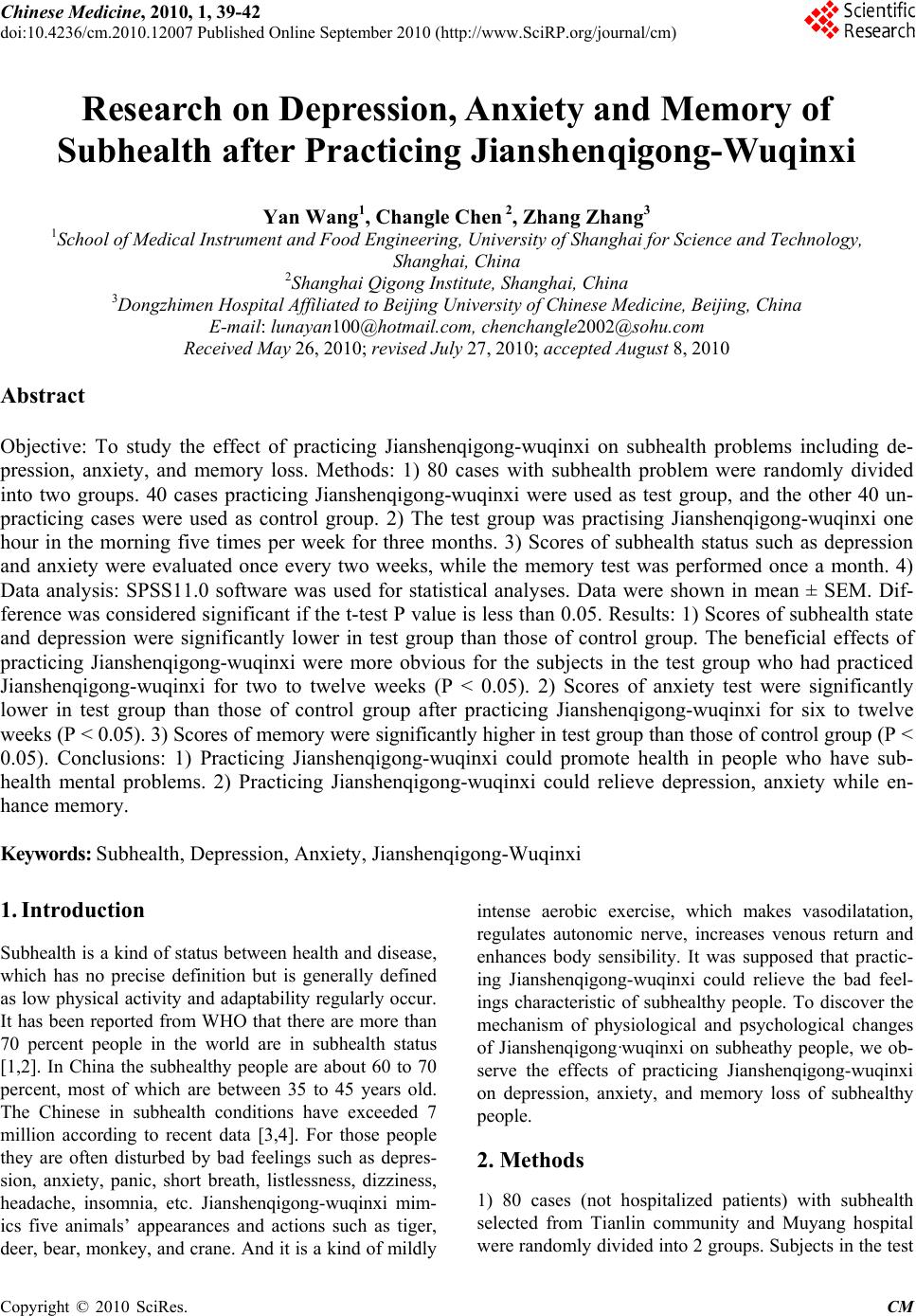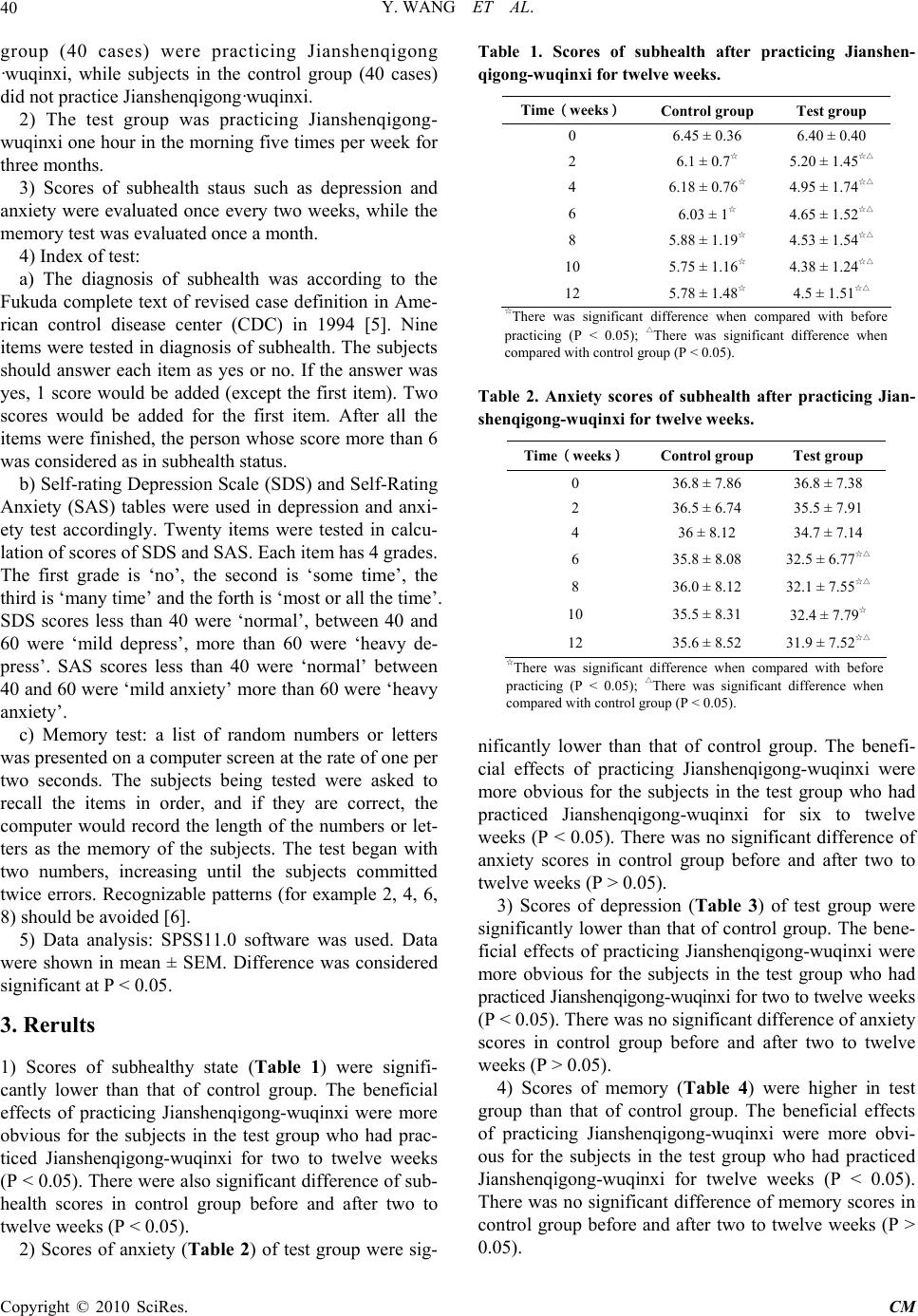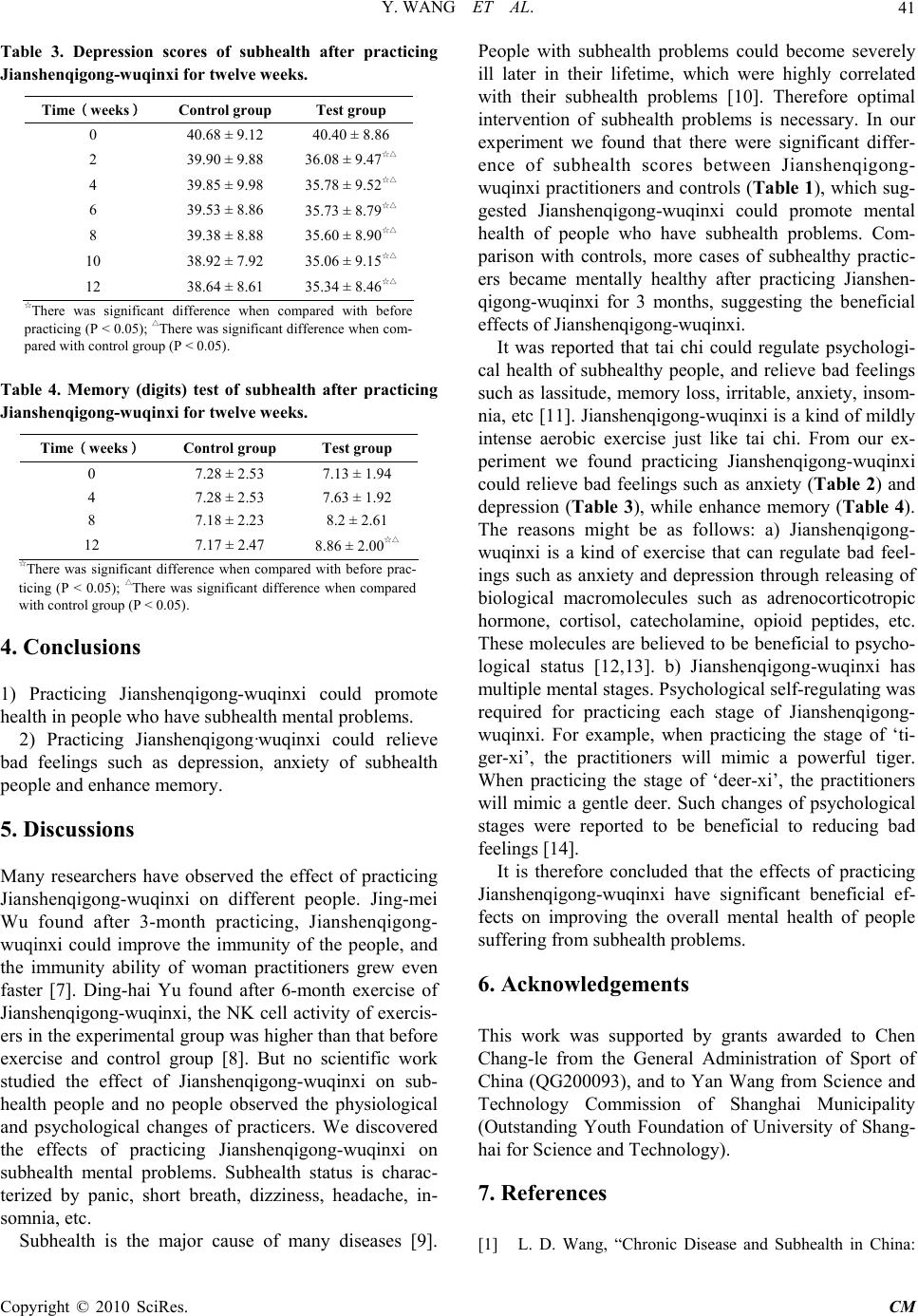Paper Menu >>
Journal Menu >>
 Chinese Medicine, 2010, 1, 39-42 doi:10.4236/cm.2010.12007 Published Online September 2010 (http://www.SciRP.org/journal/cm) Copyright © 2010 SciRes. CM Research on Depression, A nxiety and Memory of Subhealth after Practicing Jianshenqigong-Wuqinxi Yan Wang1, Changle Chen 2, Zhang Zhang3 1School of Medical Instrument and Food Engineering, University of Shanghai for Science and Technology, Shanghai, China 2Shanghai Qigong Institute, Shanghai, China 3Dongzhimen Hospital Affiliated to Beijing University of Chinese Medicine, Beijing, China E-mail: lunayan100@hotmail.com, chenchangle2002@sohu.com Received May 26, 2010; revised July 27, 2010; accepted August 8, 2010 Abstract Objective: To study the effect of practicing Jianshenqigong-wuqinxi on subhealth problems including de- pression, anxiety, and memory loss. Methods: 1) 80 cases with subhealth problem were randomly divided into two groups. 40 cases practicing Jianshenqigong-wuqinxi were used as test group, and the other 40 un- practicing cases were used as control group. 2) The test group was practising Jianshenqigong-wuqinxi one hour in the morning five times per week for three months. 3) Scores of subhealth status such as depression and anxiety were evaluated once every two weeks, while the memory test was performed once a month. 4) Data analysis: SPSS11.0 software was used for statistical analyses. Data were shown in mean ± SEM. Dif- ference was considered significant if the t-test P value is less than 0.05. Results: 1) Scores of subhealth state and depression were significantly lower in test group than those of control group. The beneficial effects of practicing Jianshenqigong-wuqinxi were more obvious for the subjects in the test group who had practiced Jianshenqigong-wuqinxi for two to twelve weeks (P < 0.05). 2) Scores of anxiety test were significantly lower in test group than those of control group after practicing Jianshenqigong-wuqinxi for six to twelve weeks (P < 0.05). 3) Scores of memory were significantly higher in test group th an those of co ntrol group (P < 0.05). Conclusions: 1) Practicing Jianshenqigong-wuqinxi could promote health in people who have sub- health mental problems. 2) Practicing Jianshenqigong-wuqinxi could relieve depression, anxiety while en- han c e me mor y . Keywords: Subhealth, Depression, Anxiety, Jianshenqigong-Wuqinxi 1. Introduction Subhealth is a kind of status between health and disease, which has no precise definition but is generally defined as low physical activity and adaptability regularly occur. It has been reported from WHO that there are more than 70 percent people in the world are in subhealth status [1,2]. In China the subhealthy people are about 60 to 70 percent, most of which are between 35 to 45 years old. The Chinese in subhealth conditions have exceeded 7 million according to recent data [3,4]. For those people they are often disturbed by bad feelings such as depres- sion, anxiety, panic, short breath, listlessness, dizziness, headache, insomnia, etc. Jianshenqigong-wuqinxi mim- ics five animals’ appearances and actions such as tiger, deer, bear, monkey, and crane. And it is a kind of mildly intense aerobic exercise, which makes vasodilatation, regulates autonomic nerve, increases venous return and enhances body sensibility. It was supposed that practic- ing Jianshenqigong-wuqinxi could relieve the bad feel- ings characteristic of subhealthy people. To discover the mechanism of physiological and psychological changes of Jianshenqigong·wuqinxi on subheathy people, we ob- serve the effects of practicing Jianshenqigong-wuqinxi on depression, anxiety, and memory loss of subhealthy people. 2. Methods 1) 80 cases (not hospitalized patients) with subhealth selected from Tianlin community and Muyang hospital were randomly divided into 2 groups. Subjects in the test  Y. WANG ET AL. Copyright © 2010 SciRes. CM 40 group (40 cases) were practicing Jianshenqigong ·wuqinxi, while subjects in the control group (40 cases) did not practice Jianshenqigong·wuqinxi. 2) The test group was practicing Jianshenqigong- wuqinxi one hour in the morning five ti mes per week for three months. 3) Scores of subhealth staus such as depression and anxiety were evaluated once every two weeks, while the memory test was evaluated once a month. 4) Index of test: a) The diagnosis of subhealth was according to the Fukuda complete text of revised case definition in Ame- rican control disease center (CDC) in 1994 [5]. Nine items were tested in diagnosis of subhealth. The sub jects should answer each item as yes or no. If the answer was yes, 1 score would be added (except the first item). Two scores would be added for the first item. After all the items were finished, the person whose score more than 6 was considered as in subhealth status. b) Self-rating Depression Scale (SDS) and Self-Rating Anxiety (SAS) tables were used in depression and anxi- ety test accordingly. Twenty items were tested in calcu- lation of scores of SDS and SAS. Each item has 4 grades. The first grade is ‘no’, the second is ‘some time’, the third is ‘many time’ and the forth is ‘most or all the time’. SDS scores less than 40 were ‘normal’, between 40 and 60 were ‘mild depress’, more than 60 were ‘heavy de- press’. SAS scores less than 40 were ‘normal’ between 40 and 60 were ‘mild anxiety’ more than 60 were ‘heavy anxiety’. c) Memory test: a list of random numbers or letters was presented on a computer screen at the rate of one per two seconds. The subjects being tested were asked to recall the items in order, and if they are correct, the computer would record the length of the numbers or let- ters as the memory of the subjects. The test began with two numbers, increasing until the subjects committed twice errors. Recognizable patterns (for example 2, 4, 6, 8) should be avoided [6]. 5) Data analysis: SPSS11.0 software was used. Data were shown in mean ± SEM. Difference was considered significant at P < 0.05. 3. Rerults 1) Scores of subhealthy state (Table 1) were signifi- cantly lower than that of control group. The beneficial effects of practicing Jianshenqigong-wuqinxi were more obvious for the subjects in the test group who had prac- ticed Jianshenqigong-wuqinxi for two to twelve weeks (P < 0.05). There were also significant difference of sub- health scores in control group before and after two to twelve weeks (P < 0.05). 2) Scores of anxiety (Table 2) of test group were sig- Table 1. Scores of subhealth after practicing Jianshen- qigong-wuqinxi for twelve weeks. Time(weeks) Control group Test group 0 6.45 ± 0.36 6.40 ± 0.40 2 6.1 ± 0.7☆ 5.20 ± 1.45☆△ 4 6.18 ± 0.76☆ 4.95 ± 1.74☆△ 6 6.03 ± 1☆ 4.65 ± 1.52☆△ 8 5.88 ± 1.19☆ 4.53 ± 1.54☆△ 10 5.75 ± 1.16☆ 4.38 ± 1.24☆△ 12 5.78 ± 1.48☆ 4.5 ± 1.51☆△ ☆There was significant difference when compared with before practicing (P < 0.05); △There was significant difference when compare d with control group (P < 0.05). Table 2. Anxiety scores of subhealth after practicing Jian- shenqigong-wuqinxi for twelve we eks. Time(weeks) Control group Test group 0 36.8 ± 7.86 36.8 ± 7.38 2 36.5 ± 6.74 35.5 ± 7.91 4 36 ± 8.12 34.7 ± 7.14 6 35.8 ± 8.08 32.5 ± 6.77☆△ 8 36.0 ± 8.12 32.1 ± 7.55☆△ 10 35.5 ± 8.31 32.4 ± 7.79☆ 12 35.6 ± 8.52 31.9 ± 7.52☆△ ☆There was significant difference when compared with before practicing (P < 0.05); △There was significant difference when compare d with control group (P < 0.05). nificantly lower than that of control group. The benefi- cial effects of practicing Jianshenqigong-wuqinxi were more obvious for the subjects in the test group who had practiced Jianshenqigong-wuqinxi for six to twelve weeks (P < 0.05). There was no significant difference of anxiety scores in control group before and after two to twelve weeks (P > 0.05). 3) Scores of depression (Table 3) of test group were significantly lower than that of control group. The bene- ficial effects of practicing Jianshenqigong-wuqinxi were more obvious for the subjects in the test group who had practiced Jianshenqigong-wuqinxi for two to twelve we e k s (P < 0.05). There was no significant difference of anxiety scores in control group before and after two to twelve weeks (P > 0.05). 4) Scores of memory (Table 4) were higher in test group than that of control group. The beneficial effects of practicing Jianshenqigong-wuqinxi were more obvi- ous for the subjects in the test group who had practiced Jianshenqigong-wuqinxi for twelve weeks (P < 0.05). There was no significant difference of memory scores in control group before and after two to twelve weeks (P > 0.05).  Y. WANG ET AL. Copyright © 2010 SciRes. CM 41 Table 3. Depression scores of subhealth after practicing Jianshenqigong-wuqinxi for twelve weeks. Time(weeks) Control group Test group 0 40.68 ± 9.12 40.40 ± 8.86 2 39.90 ± 9.88 36.08 ± 9.47☆△ 4 39.85 ± 9.98 35.78 ± 9.52☆△ 6 39.53 ± 8.86 35.73 ± 8.79☆△ 8 39.38 ± 8.88 35.60 ± 8.90☆△ 10 38.92 ± 7.92 35.06 ± 9.15☆△ 12 38.64 ± 8.61 35.34 ± 8.46☆△ ☆There was significant difference when compared with before practicing (P < 0.05); △There was significant diff erence when co m- pared with c ontrol group (P < 0.05). Table 4. Memory (digits) test of subhealth after practicing Jianshenqigong-wuqinxi for twelve weeks. Time(weeks) Control group Test group 0 7.28 ± 2.53 7.13 ± 1.94 4 7.28 ± 2.53 7.63 ± 1.92 8 7.18 ± 2.23 8.2 ± 2.61 12 7.17 ± 2.47 8.86 ± 2.00☆△ ☆There was significant difference when compared with before prac- ticing (P < 0.05); △There was significant difference when compared with control group (P < 0.05). 4. Conclusions 1) Practicing Jianshenqigong-wuqinxi could promote health in people who have subhealth mental problems. 2) Practicing Jianshenqigong·wuqinxi could relieve bad feelings such as depression, anxiety of subhealth people and enhance memory. 5. Discussions Many researchers have observed the effect of practicing Jianshenqigong-wuqinxi on different people. Jing-mei Wu found after 3-month practicing, Jianshenqigong- wuqinxi could improve the immunity of the people, and the immunity ability of woman practitioners grew even faster [7]. Ding-hai Yu found after 6-month exercise of Jianshenqigong-wuqinxi, the NK cell activity of exercis- ers in the experimental group was higher than that before exercise and control group [8]. But no scientific work studied the effect of Jianshenqigong-wuqinxi on sub- health people and no people observed the physiological and psychological changes of practicers. We discovered the effects of practicing Jianshenqigong-wuqinxi on subhealth mental problems. Subhealth status is charac- terized by panic, short breath, dizziness, headache, in- somnia, etc. Subhealth is the major cause of many diseases [9]. People with subhealth problems could become severely ill later in their lifetime, which were highly correlated with their subhealth problems [10]. Therefore optimal intervention of subhealth problems is necessary. In our experiment we found that there were significant differ- ence of subhealth scores between Jianshenqigong- wuqinxi practitioners and controls (Ta ble 1), which sug- gested Jianshenqigong-wuqinxi could promote mental health of people who have subhealth problems. Com- parison with controls, more cases of subhealthy practic- ers became mentally healthy after practicing Jianshen- qigong-wuqinxi for 3 months, suggesting the beneficial effects of Jianshenqigong-wuqinxi. It was reported that tai chi could regulate psychologi- cal health of subhealthy people, and relieve bad feelings such as lassitude, memory loss, irritable, anxiety, insom- nia, etc [11]. Jianshenqigong-wuqinxi is a kind of mildly intense aerobic exercise just like tai chi. From our ex- periment we found practicing Jianshenqigong-wuqinxi could relieve bad feelings such as anxiety (Table 2) and depression (Table 3), while enhance memory (Table 4). The reasons might be as follows: a) Jianshenqigong- wuqinxi is a kind of exercise that can regulate bad feel- ings such as anxiety and depression through releasing of biological macromolecules such as adrenocorticotropic hormone, cortisol, catecholamine, opioid peptides, etc. These molecules are believed to be beneficial to psycho- logical status [12,13]. b) Jianshenqigong-wuqinxi has multiple mental stages. Psychological self-regulating was required for practicing each stage of Jianshenqigong- wuqinxi. For example, when practicing the stage of ‘ti- ger-xi’, the practitioners will mimic a powerful tiger. When practicing the stage of ‘deer-xi’, the practitioners will mimic a gentle deer. Such changes of psychological stages were reported to be beneficial to reducing bad feelings [14]. It is therefore concluded that the effects of practicing Jianshenqigong-wuqinxi have significant beneficial ef- fects on improving the overall mental health of people suffering from subhealth problems. 6. Acknowledgements This work was supported by grants awarded to Chen Chang-le from the General Administration of Sport of China (QG200093), and to Yan Wang from Science and Technology Commission of Shanghai Municipality (Outstanding Youth Foundation of University of Shang- hai for Science and Technology). 7. References [1] L. D. Wang, “Chronic Disease and Subhealth in China:  Y. WANG ET AL. Copyright © 2010 SciRes. CM 42 The Effect and the Guideline of Prevention and Treat- ment,” Chinese Medical Journal, Vol. 83, No. 12, June 2003, pp.1031-1034. [2] X. L. Wang, Y. H. Huo, J. Li, X. S. Zhao and R. Luo, “Evaluation of the Questionnaire for Subhealth Status Survey Based on the Symptoms in Traditional Chinese Medicine,” Journal of Southern Medical University, Vol. 27, No. 2, February 2007, pp. 160-163. [3] T. F. Wang, J. J. Wang, X. L. Xue , P. Han, Y. J. Zhang, G. R. Li, X. Y. Wu, Y. Zhao, L. L. Tang, Y. Y. Liu, C. L. Sui, C. Fu, Y. M. Shang and B. Zhou, “Distribution Charac- teristics of Traditional Chinese Medicine Syndromes and their Elements in People with Subhealth Fatigue,” Jour- nal of Chinese Integrative Medicine, Vol. 8, No. 3, March 2010, pp. 220-223. [4] Y. H. Huo, X. L. Wang, J. Li, C. Y. Zhu, X. M. Sun, X. S. Zhao, C. Zhang and R. Luo, “Analysis of Clinical Mani- festations of Subheath Status in a Medical College of Guangdong Province,” Journal of Southern Medical Uni- versity, Vol. 27, No. 4, April 2007, pp. 448-449. [5] K. Fukuda, S. E. Straus, I. Hickie, M. C. Sharpe, J. G. Dobbins and A. Komaroff, “The Chronic Fatigue Syn- drome: A Comprehensive Approach to its Definition and Study. International Chronic Fatigue Syndrome Study Group,” Annals of Internal Medicine, Vol. 121, No. 12, December 1994, pp. 953-959. [6] G. Miller, “The Magical Number Seven, Plus or Minus Two: Some Limits on Our Capacity for Processing In- formation,” Psychological Review, Vol. 101, No. 2, April 1994, pp. 343-352. [7] J. M. Wu and D. H. Yu “Research on Effects of Practic- ing ‘Wuqinxi’ on the Outer Sub-Group of T-Cell of the Middle-Aged and Old People,” Journal of Beijing Sport University, Vol. 29, No. 8, August 2006, pp. 1074-1076. [8] D. H. Yu and J. M. Wu, “Effects of Exercising Build- ing-Up Qigong-Wuqinxi on Middle-Aged and Old Peo- ple’s NK Cell Activity,” Journal of Shanghai University of Sport, Vol. 32, No. 1, January 2008, pp. 56-59. [9] H. W. Jiang, “Integrative Medical Research Thinking on the Constitution-Subhealth-Disease Relation Developing Axis,” Chinese Journal of Integrated Traditional and Western Medicine, Vol. 29, No. 9, September 2009, pp. 836-837. [10] C. X. Fan, S. Y. Wang, L. Zhu, Y. J. Xiao and S. B. Ma, “Study on the Prevalence and Risk Factors of ‘Subhealth’ Status in College and University Staff in Guangdong Province,” Zhonghua Liu Xing Bing Xue Za Zhi, Vol. 24, No. 9, September 2003, pp. 774-777. [11] H. Yin and J. Yang, “Rehabilitative Effects of Taichi Exercise on the Subhealthy Status of College Students,” Journal of Clinical Rehabilitative Tissue Engineering Research, Vol. 39, No. 11, 2007, pp. 7991-7992. [12] M. A. Nies and C. L. Motyka, “Factors Contributing to Women’s Ability to Maintain a Walking Program,” Journal of Holistic Nursing, Vol. 24, No. 1, March 2006, pp. 7-14. [13] B. B. Simen, C. H. Duman, A. A. Simen and R. S. Du- man, “TNFalpha Signaling in Depression and Anxiety: Behavioral Consequences of Individual Receptor Target- ing,” Biological Psychiatry, Vol. 59, N o. 9, Feb ruary 2006, pp. 775-785. [14] A.-H. Peng and Z. Yan, “Analysis of Epidemiological Status and Countermeasures for Sub-Health Problem among Occupational Poputation in China,” Modern Pre- ventive Medicine, Vol. 36, No. 14, November 2009, pp. 2617-2619. |

